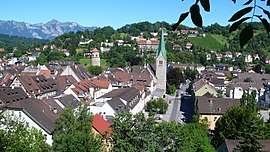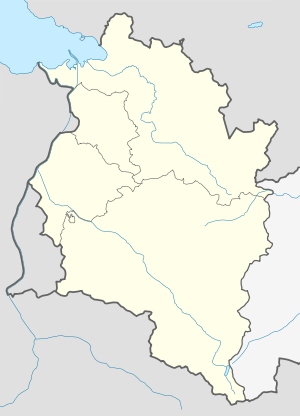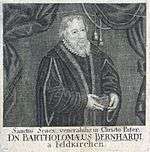Feldkirch, Vorarlberg
Feldkirch (German pronunciation: [ˈfɛltkɪʁç]) is a medieval town in the western Austrian state of Vorarlberg, bordering on Switzerland and Liechtenstein. It is the administrative centre of the Feldkirch district. After Dornbirn, it is the second most populous town in Vorarlberg. The westernmost point in Austria lies in Feldkirch on the river Rhine, at the tripoint between Austria, Switzerland, and Liechtenstein.
Feldkirch | |
|---|---|
 | |
 Coat of arms | |
 Feldkirch Location within Austria  Feldkirch Feldkirch (Austria) | |
| Coordinates: 47°14′17″N 09°35′54″E | |
| Country | |
| State | Vorarlberg |
| District | Feldkirch |
| Government | |
| • Mayor | Wilfried Berchtold (ÖVP) |
| Area | |
| • Total | 34.34 km2 (13.26 sq mi) |
| Elevation | 458 m (1,503 ft) |
| Population (2018-01-01)[2] | |
| • Total | 33,420 |
| • Density | 970/km2 (2,500/sq mi) |
| Time zone | UTC+1 (CET) |
| • Summer (DST) | UTC+2 (CEST) |
| Postal code | 6800 |
| Area code | 05522 |
| Vehicle registration | FK |
| Website | www.feldkirch.at |
History
This beautiful medieval town, which remains well preserved to this day, was mentioned as a city for the first time in 1218, after Count Hugo von Montfort built the "Schattenburg", a castle which still is the major landmark of Feldkirch. Other sights in the town include the Gothic-style cathedral of St. Nikolaus. Feldkirch was the birthplace of Rheticus, and is currently the seat of the Roman Catholic Diocese of Feldkirch. From 1651–1773 and from 1856–1979, Feldkirch was the home of the Jesuit school Stella Matutina.
March 1799 saw two clashes between the forces of the First French Republic and the Habsburg Monarchy. On the 7th, Nicolas Oudinot, with 9,000 French soldiers, defeated Friedrich Freiherr von Hotze and his 6,000 Austrians. The Battle of Feldkirch occurred on 23 March, when André Masséna and 12,000 Frenchmen were beaten by Franz Jellacic and a force of 5,500 Austrians.[3]
Town subdivisions
- Feldkirch
- Altenstadt
- Gisingen
- Levis
- Nofels
- Tisis
- Tosters
Population
| Year | Pop. | ±% |
|---|---|---|
| 1869 | 6,186 | — |
| 1880 | 7,322 | +18.4% |
| 1890 | 8,039 | +9.8% |
| 1900 | 9,755 | +21.3% |
| 1910 | 11,830 | +21.3% |
| 1923 | 11,896 | +0.6% |
| 1934 | 12,909 | +8.5% |
| 1939 | 13,067 | +1.2% |
| 1951 | 15,115 | +15.7% |
| 1961 | 17,343 | +14.7% |
| 1971 | 21,751 | +25.4% |
| 1981 | 23,745 | +9.2% |
| 1991 | 26,730 | +12.6% |
| 2001 | 28,607 | +7.0% |
| 2011 | 30,975 | +8.3% |
| 2014 | 31,428 | +1.5% |
| 2015 | 31,824 | +1.3% |
Economy and infrastructure
Transport
Feldkirch has had its own local bus network since 1993. It currently consists of eight lines, including buses which run to the north of neighbouring Liechtenstein. The bus system cooperates with Vorarlberg's regional bus system. The
Feldkirch railway station lies on the main railway line through the Vorarlberg, with inter-city services to Zurich and Vienna. There are also local international trains to Buchs via Liechtenstein on the Feldkirch–Buchs railway.
Companies
The following companies and service organizations are based in Feldkirch:
- Bachmann Electronic
- Vorarlberg Milch
- Lingenhöle Technologie
- Stadtwerke Feldkirch
- KSW Tankstellen- und Industrieanlagenbau
- Gebäudereinigung Bauer
- Landeskrankenhaus Feldkirch
Culture and landmarks
Central Feldkirch
Feldkirch has one of the best preserved medieval townscapes of Vorarlberg. The town was built around 1200 and has a geometric grid system. Since around 1500, when the city wall was rebuilt, the city has remained unchanged over the centuries.
Since 2015, the Feldkirch Municipal Ensemble has been listed in the Austrian List of Cultural Heritage (cultural property protected by the Hague Convention). The city is also a member of the Association of Small Historic Towns, a tourism marketing association.[4]
City fortification
The streets of the Schlossgraben, Hirschgraben and St. Leonhardsplatz marked the former course of the city wall surrounding the Neustadt area in the 13th century. The wall was largely rebuilt around 1500, and torn down in many places beginning in 1826.[5]
When Feldkirch was surrounded by a city wall and a city moat, one could enter the city only through one of its four gates. These city gates were called Bregenzertor or Nikolaustor, Bludenzertor or Schultor, Milltor or Sautor, and Churertor or Salztor. The last two gates are still standing, the other two were removed together with the city wall at the beginning of the 19th century.[6]
Castles and palaces
- Schattenburg: The Schattenburg castle was the seat of the counts of Montfort until 1390. The first construction phase began around 1230 under Hugo I of Montfort, the founder of the city. Under Count Friedrich von Toggenburg (1416–1436) and under the Vogt Hans of Königsegg extensions and transformations of the Schattenburg castle were built in the 15th century. After the counts lost their power, the castle was repeatedly put up for auction, and was even to be demolished in 1813. Since 1825 the castle has been owned by the town of Feldkirch, which at that time acquired it for 833 florins. The castle then served as barracks, and later as accommodation for the poor. The castle owes its rescue and revitalization to the Museum and Homeland Security Association for Feldkirch and the Surrounding Area which was founded in 1912. The upper floors are home to a museum of local history that attracts about 25,000 visitors annually.[7]
- Ruins of Tosters: The ruins of a hill castle on a hillside part of the Schellenberg, in the Feldkirch district of Tosters.
- Palais Liechtenstein: In today's form, the house was built in the Schlossergasse No. 8 after the town fire of 1697, as an office building for the prince Johann Adam Andreas of Liechtenstein in Baroque style. In 1848 it became the property of Andreas Ritter of Tschavoll, at that time Feldkirch mayor and manufacturer. The town acquired the palais in 1967 and today the building is used as an exhibition centre. It is home of the cultural council, and also the seat of the city library and the city archives.[8]
Villas and other residential buildings
In the 19th century the Feldkirch bourgeoisie built a number of prestigious residential buildings, most of which are still privately owned. The villas were built mostly on the Reichsstraße, mainly in the area between the Bärenkreuzung and the train station.
Cultural events
The Poolbar Festival is a modern music and cultural festival in Feldkirch. Held annually in July and August, it attracts around 20,000 visitors; it features music, exhibitions, poetry slams, fashion and an architectural prize. It was first held in 1994 as a cultural summer-academy and is, in its organization and implementation of landscape and architecture, very different from other open-air events.[9]
Feldkirch is the home of the Feldkirch Festival, an annual summer festival founded in 2002 by Thomas Hengelbrock and directed since 2007 by Philippe Arlaud.[10]
The POTENTIALe (formerly 'ArtDesign Feldkirch') is an art fair and festival at which about 110 exhibitors present their products and ideas. In addition to a vintage market, there are workshops and discussion groups, a 'design laboratory', photography exhibitions, and music and films are presented.[11]
Climate
Feldkirch has a oceanic climate (Cfb).
| Feldkirch, Vorarlberg | ||||||||||||||||||||||||||||||||||||||||||||||||||||||||||||
|---|---|---|---|---|---|---|---|---|---|---|---|---|---|---|---|---|---|---|---|---|---|---|---|---|---|---|---|---|---|---|---|---|---|---|---|---|---|---|---|---|---|---|---|---|---|---|---|---|---|---|---|---|---|---|---|---|---|---|---|---|
| Climate chart (explanation) | ||||||||||||||||||||||||||||||||||||||||||||||||||||||||||||
| ||||||||||||||||||||||||||||||||||||||||||||||||||||||||||||
| ||||||||||||||||||||||||||||||||||||||||||||||||||||||||||||
| Climate data for Feldkirch, Vorarlberg (1981–2010) | |||||||||||||
|---|---|---|---|---|---|---|---|---|---|---|---|---|---|
| Month | Jan | Feb | Mar | Apr | May | Jun | Jul | Aug | Sep | Oct | Nov | Dec | Year |
| Record high °C (°F) | 19.2 (66.6) |
21.5 (70.7) |
24.6 (76.3) |
29.8 (85.6) |
32.5 (90.5) |
35.6 (96.1) |
38.1 (100.6) |
35.5 (95.9) |
30.0 (86.0) |
29.7 (85.5) |
25.2 (77.4) |
21.8 (71.2) |
38.1 (100.6) |
| Average high °C (°F) | 3.4 (38.1) |
5.4 (41.7) |
10.6 (51.1) |
15.1 (59.2) |
19.9 (67.8) |
22.5 (72.5) |
24.7 (76.5) |
23.9 (75.0) |
19.6 (67.3) |
15.0 (59.0) |
8.2 (46.8) |
4.2 (39.6) |
14.4 (57.9) |
| Daily mean °C (°F) | 0.0 (32.0) |
1.0 (33.8) |
5.3 (41.5) |
9.4 (48.9) |
14.1 (57.4) |
17.0 (62.6) |
19.0 (66.2) |
18.2 (64.8) |
14.1 (57.4) |
9.8 (49.6) |
4.4 (39.9) |
1.2 (34.2) |
9.5 (49.1) |
| Average low °C (°F) | −3.3 (26.1) |
−2.6 (27.3) |
1.2 (34.2) |
4.6 (40.3) |
9.1 (48.4) |
12.2 (54.0) |
14.2 (57.6) |
13.8 (56.8) |
10.2 (50.4) |
6.3 (43.3) |
1.2 (34.2) |
−1.9 (28.6) |
5.4 (41.7) |
| Record low °C (°F) | −22.6 (−8.7) |
−17.5 (0.5) |
−15.0 (5.0) |
−5.0 (23.0) |
−0.2 (31.6) |
3.0 (37.4) |
6.4 (43.5) |
5.2 (41.4) |
1.0 (33.8) |
−6.3 (20.7) |
−12.0 (10.4) |
−14.6 (5.7) |
−22.6 (−8.7) |
| Average precipitation mm (inches) | 72 (2.8) |
68 (2.7) |
89 (3.5) |
89 (3.5) |
124 (4.9) |
155 (6.1) |
182 (7.2) |
182 (7.2) |
131 (5.2) |
86 (3.4) |
92 (3.6) |
89 (3.5) |
1,360 (53.5) |
| Average snowfall cm (inches) | 20 (7.9) |
21 (8.3) |
10 (3.9) |
2 (0.8) |
0 (0) |
0 (0) |
0 (0) |
0 (0) |
0 (0) |
0 (0) |
8 (3.1) |
19 (7.5) |
79 (31) |
| Average relative humidity (%) (at 14:00) | 74.3 | 66.7 | 57.3 | 53.7 | 55.3 | 57.1 | 58.2 | 60.5 | 63.4 | 66.9 | 73.5 | 76.9 | 63.6 |
| Mean monthly sunshine hours | 71 | 104 | 142 | 173 | 199 | 203 | 226 | 211 | 162 | 130 | 76 | 55 | 1,754 |
| Source: Central Institute for Meteorology and Geodynamics[12][13][14][15][16] | |||||||||||||
| Climate data for Feldkirch, Vorarlberg (1971–2000) | |||||||||||||
|---|---|---|---|---|---|---|---|---|---|---|---|---|---|
| Month | Jan | Feb | Mar | Apr | May | Jun | Jul | Aug | Sep | Oct | Nov | Dec | Year |
| Record high °C (°F) | 19.2 (66.6) |
21.2 (70.2) |
25.0 (77.0) |
29.8 (85.6) |
31.8 (89.2) |
34.8 (94.6) |
38.1 (100.6) |
35.4 (95.7) |
32.8 (91.0) |
29.7 (85.5) |
25.2 (77.4) |
21.8 (71.2) |
38.1 (100.6) |
| Average high °C (°F) | 3.0 (37.4) |
5.2 (41.4) |
10.3 (50.5) |
14.1 (57.4) |
19.2 (66.6) |
21.7 (71.1) |
23.9 (75.0) |
23.5 (74.3) |
19.6 (67.3) |
14.1 (57.4) |
7.6 (45.7) |
4.1 (39.4) |
13.9 (57.0) |
| Daily mean °C (°F) | −0.7 (30.7) |
0.7 (33.3) |
4.8 (40.6) |
8.4 (47.1) |
13.5 (56.3) |
16.3 (61.3) |
18.4 (65.1) |
17.9 (64.2) |
13.9 (57.0) |
9.0 (48.2) |
3.5 (38.3) |
0.5 (32.9) |
8.9 (48.0) |
| Average low °C (°F) | −3.4 (25.9) |
−2.4 (27.7) |
1.0 (33.8) |
3.9 (39.0) |
8.4 (47.1) |
11.4 (52.5) |
13.5 (56.3) |
13.3 (55.9) |
9.8 (49.6) |
5.6 (42.1) |
0.7 (33.3) |
−2.1 (28.2) |
5.0 (41.0) |
| Record low °C (°F) | −22.6 (−8.7) |
−17.5 (0.5) |
−17.0 (1.4) |
−5.0 (23.0) |
−0.6 (30.9) |
3.0 (37.4) |
5.4 (41.7) |
5.0 (41.0) |
−1.0 (30.2) |
−6.3 (20.7) |
−12.0 (10.4) |
−21.6 (−6.9) |
−22.6 (−8.7) |
| Average precipitation mm (inches) | 68.0 (2.68) |
65.3 (2.57) |
72.9 (2.87) |
86.6 (3.41) |
106.7 (4.20) |
150.5 (5.93) |
165.3 (6.51) |
152.1 (5.99) |
113.2 (4.46) |
78.0 (3.07) |
92.1 (3.63) |
80.3 (3.16) |
1,231 (48.46) |
| Average snowfall cm (inches) | 19.2 (7.6) |
20.7 (8.1) |
9.4 (3.7) |
2.0 (0.8) |
0.2 (0.1) |
0.0 (0.0) |
0.0 (0.0) |
0.0 (0.0) |
0.0 (0.0) |
0.0 (0.0) |
10.3 (4.1) |
14.6 (5.7) |
76.4 (30.1) |
| Average precipitation days (≥ 1.0 mm) | 10.3 | 9.3 | 11.7 | 12.7 | 13.2 | 14.8 | 14.6 | 13.6 | 10.8 | 9.5 | 11.2 | 11.0 | 142.7 |
| Average relative humidity (%) (at 14:00) | 74.7 | 66.9 | 55.4 | 52.6 | 53.1 | 55.8 | 56.8 | 58.4 | 60.5 | 65.7 | 72.8 | 76.3 | 62.4 |
| Mean monthly sunshine hours | 60.0 | 95.5 | 134.5 | 159.8 | 193.6 | 191.0 | 215.0 | 207.8 | 165.5 | 115.2 | 72.0 | 51.6 | 1,661.5 |
| Percent possible sunshine | 24.6 | 37.4 | 41.0 | 42.7 | 43.9 | 43.0 | 49.0 | 51.0 | 49.3 | 39.6 | 29.4 | 23.4 | 39.5 |
| Source: Central Institute for Meteorology and Geodynamics[17] | |||||||||||||
Schools
- Bundesgymnasium und Bundesrealgymnasium Feldkirch (founded in 1649)
- Bundeshandelsakademie und Bundeshandelsschule Feldkirch
- Bundesoberstufenrealgymnasium und Bundesrealgymnasium Schillerstrasse (GYS)& Musikgymnasium Feldkirch www.gys.at
- Bundeshandelsakademie und Handelsschule Feldkirch
- Institut St. Josef
- Musikschule der Stadt Feldkirch
- Stella Matutina (Jesuit school) (former)
- Pädagogische Hochschule des Bundes in Vorarlberg
- Vorarlberger Landeskonservatorium
Notable people

- Bartholomäus Bernhardi (1487–1551), Lutheran theologian
- Wolf Huber (c. 1485–1553), painter (Danube school) and architect
- Georg Joachim Rheticus (1514–1574), mathematician and astronomer
- Karl Bleyle (1880–1969), musician and composer
- Elmar Fischer (born 1936), bishop of the Feldkirch diocese
- Bernhard Leitner (born 1938), artist
- P. Georg Sporschill SJ (born 1946), pastor known for his social engagement for orphans and street children in Romania and Moldova and work with the homeless in Vienna.
- Wiltrud Drexel (born 1950), ski racer
- Günther Freitag (born 1952), novelist
- Herbert Bösch (born 1954), politician and MEP
- Hans Weingartner (born 1970), author, director and film producer (famous for the international hit The Edukators starring Daniel Brühl and Julia Jentsch).
Sport clubs
- VEU Feldkirch
- TC-ESV Feldkirch
- Tennisclub Swietelsky Blau-Weiss Feldkirch
- TSV Altenstadt
- SC Tisis
- FC Blau-Weiß Feldkirch
- Baseball- and Softballclub Feldkirch Cardinals
- Metafund Baskets Feldkirch (Basketball)
- HC Blau-Weiß Feldkirch
- Sportbillardclub Feldkirch
- Schiverein Tisis
- Volleyballclub SSK Feldkirch
Twin towns
See also
References
- "Dauersiedlungsraum der Gemeinden Politischen Bezirke und Bundesländer - Gebietsstand 1.1.2018". Statistics Austria. Retrieved 10 March 2019.
- "Einwohnerzahl 1.1.2018 nach Gemeinden mit Status, Gebietsstand 1.1.2018". Statistics Austria. Retrieved 9 March 2019.
- Smith, Digby (1998). The Napoleonic Wars Data Book. London: Greenhill. pp. 146–148. ISBN 1-85367-276-9.
- "Small historic towns". Archived from the original on 2016-03-24.
- Salzburg. "Local history of Feldkirch - Small historic towns". www.khs.info. Retrieved 2017-07-21.
- Salzburg. "Sights in Feldkirch - Small historic towns". www.khs.info. Retrieved 2017-07-21.
- "Schattenburg-Museum Räume". www.schattenburg.at (in German). Retrieved 2017-07-24.
- "Palais | Kunst Palais Liechtenstein". www.palaisliechtenstein.at (in German). Retrieved 2017-07-24.
- "poolbar Festival". poolbar Festival (in German). Retrieved 2019-03-03.
- Geschichte Feldkirch Festival Archived 2010-02-22 at the Wayback Machine History of the Felkirch Festival (in German)
- "Die Potentiale in Feldkirch – Messe plus Festival". Art Aurea (in German). 2019-02-26. Retrieved 2020-07-31.
- "Klimamittel 1981–2010: Lufttemperatur" (in German). Central Institute for Meteorology and Geodynamics. Archived from the original on 21 October 2019. Retrieved 19 November 2019.
- "Klimamittel 1981–2010: Niederschlag" (in German). Central Institute for Meteorology and Geodynamics. Archived from the original on 29 December 2014. Retrieved 19 November 2019.
- "Klimamittel 1981–2010: Schnee" (in German). Central Institute for Meteorology and Geodynamics. Archived from the original on 29 December 2014. Retrieved 19 November 2019.
- "Klimamittel 1981–2010: Luftfeuchtigkeit" (in German). Central Institute for Meteorology and Geodynamics. Archived from the original on 21 October 2019. Retrieved 19 November 2019.
- "Klimamittel 1981–2010: Strahlung" (in German). Central Institute for Meteorology and Geodynamics. Archived from the original on 29 December 2014. Retrieved 19 November 2019.
- "Klimadaten von Österreich 1971–2000 – Vorarlberg-Feldkirch" (in German). Central Institute for Meteorology and Geodynamics. Archived from the original on 12 October 2019. Retrieved 20 October 2019.
External links
| Wikimedia Commons has media related to Feldkirch. |
| Wikivoyage has a travel guide for Feldkirch. |